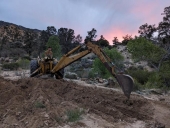John C Daley wrote:I think you may be going " up the garden path"
I like gardens and I like that it's higher in limestone than regular Portland which should allow for longer term carbonation like I mentioned. Going to test it on some non structural patios using a standard concrete mix of 4 gravel, 2 sand and one (plastic) cement.
Plastic Cement & Portland Cement?
Both Ordinary Portland cement and Plastic cement are manufactured using the same II- clinker but there are major differences from there…
Different ASTM Standards
Type II-V cement is an ASTM C150 Standard Specification for Portland Cement
Plastic cement is an ASTM C1328 Standard Specification for Plastic (Stucco) Cement
Type II-V Cement
Designed for use with coarse and fine aggregates for use in concrete
Meets ACI 318 Building Requirements for Structural Concrete
General use and meets moderate and high sulfate resistance
Plastic Cement
Low strength application
Designed for use with plaster sand
High water/cement ratio
Used for more workable and cohesive application
Freeze/thaw resistant
*High limestone addition
*High entrained air content


